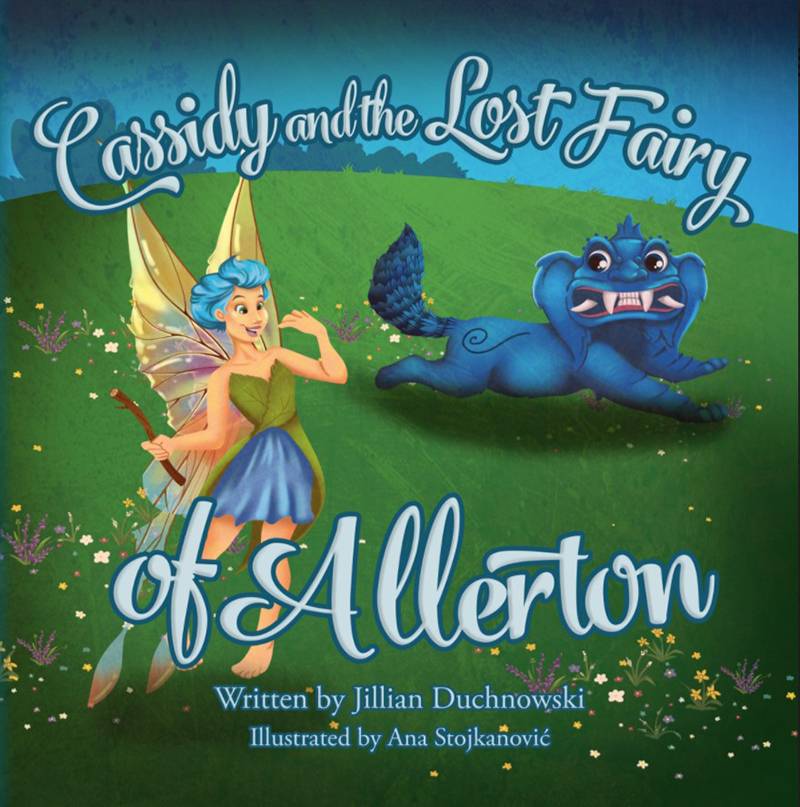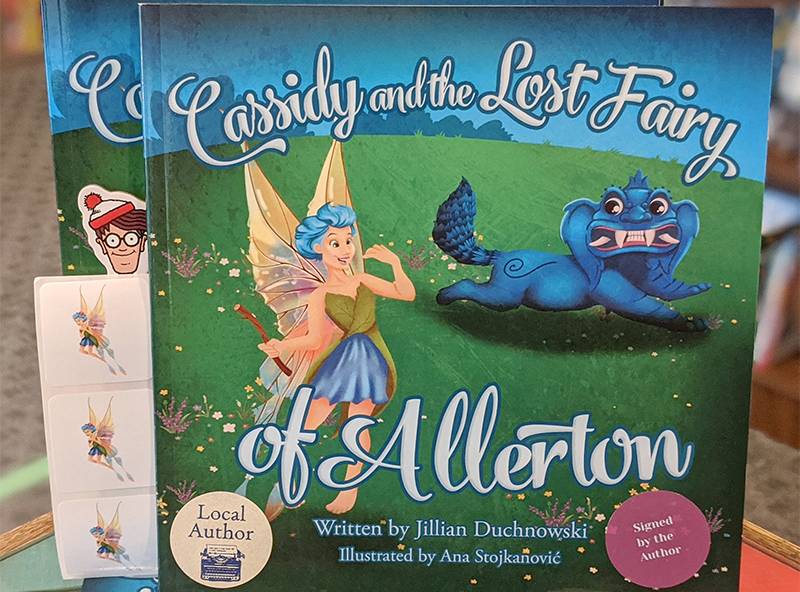Children’s books open doors into new worlds, unlock our imaginations, and, sometimes even transform our understanding of ourselves and the world we live in. For readers of all ages, they exactly what we need right now: a tonic for uncertain times. Cassidy and the Lost Fairy of Allerton, author Jillian Duchnowski’s debut children’s book, is an enchanting adventure set in one of our most treasured local parks. I recently reached out to Duchnowski to learn more about her, her life as writer, and how Cassidy and the Lost Fairy of Allerton came to be. Our conversation brought a dose of magical inspiration to my day, as I hope it will to yours.

Photo of the author from Facebook
Smile Politely: Tell us a little bit about yourself? Are you an Illinois native?
Jillian Duchnowski: I was born in Peoria but grew up in a small town outside of Ann Arbor, Michigan. I studied journalism at the University of Illinois at Urbana-Champaign and have worked for several newspapers in Illinois and Indiana.
SP: Having written Yorkville: Images of America, a work of local history, what inspired you to write a children’s book?
Duchnowski: As an author, I’m deeply interested in places. As I moved to a variety of small towns and small cities for my journalism career, I needed to quickly learn what made each place special — how newsmakers’ personalities shaped the community, but also how local industry, natural resources, etc. made that place special. I was interested in Yorkville history as a way to showcase what made Yorkville special through time even as it evolved in the face of a housing boom and rapid population growth.
Similarly, I was intrigued by Allerton Park. It’s essentially an estate built by an incredibly wealthy man who had the means to create whatever life he wanted … and he chose to develop a grand house, elaborate gardens, and walking trails, and to decorate all three with art. He chose to spend much of his time overseeing farms or travelling, so I began to think about what else he might have brought back from his travels. My imagination just wandered, and essentially, I decided to pursue a children’s book because I had never done it before.

Photo of book cover from author’s Facebook page
SP: How did the story of Cassidy and the Lost Fairy of Allerton come to be? Were you inspired by the location?
Duchnowski: Now that I’ve told this story a few times, I’ve discovered that I’m not the only one who has thought the formal gardens would be the perfect home for fairies. But my husband and I were walking down the hedge-lined path toward a statue of Adam when I noticed a break in the foliage. I stuck my head in there and realized there actually was quite a bit of space between the branches inside the hedge— it was almost like a little tunnel. I began to daydream about what other fun things might not be apparent to the naked eye.
SP: On your Amazon author’s page, you share that you had three goals in writing the book. To “to spark children’s imaginations while growing their vocabularies and their appreciation for one of the gems of Central Illinois.” In reading about you and the book, I get the sense that you are a firm believer in the power of imagination and the need for wonder. Can you talk about that a bit?
Duchnowski: I believe imagination is very important, partially because when your imagination is well-exercised, it gives you the power to change your personal outlook, even if just for a little while. One of my favorite Harry Potter quotes is from Dumbledore: “Happiness can be found, even in the darkest of times, if one only remembers to turn on the light.”
I started working on the book during a bit of a dark time. My husband and I planned a trip to Allerton to distract ourselves from the bad news that our first round of IVF had been unsuccessful. I had to acknowledge that science was not something I could control, but I very much wanted to create and be inspired and feel something other than this massive disappointment. So, I made my own little story in my head and it became a children’s book. (If you’re wondering, my IVF journey wasn’t only one of disappointment. After our third round of treatment, we discovered we were pregnant and are expecting a little girl in November.)
SP: Without giving away any spoilers, the book’s main character, Cassidy, finds herself bored with life until a bit of magic comes her way in the form of a fairy. Do you feel that a lot of young kids today feel as Cassidy does? Are they missing the sense of wonder in the world? And are places like Allerton, with its magical combination of art, history, and nature the answer?
Duchnowski: Places like Allerton certainly are one answer. I think where you find inspiration and creativity is a deeply personal thing. Some people find it in color, in music, in athleticism, in cooking, in any number of things that others might find boring. We all need to train our minds to seek that sense of wonder and give it space, both physically by supporting places like Allerton Park and emotionally by making time for day-dreaming and make-believe.
SP: I’ve been wondering if the book was written pre-COVID-19 or during? In many ways, Cassidy’s plight seems to echo how many kids are feeling during the pandemic.
Duchnowski: It was written pre-COVID, but my hope is many are able to relate to it now more than ever. Our worlds may seem a little smaller but it’s really just a matter of perspective. Everyone gets bored and restless sometimes, but to stay bored and restless is a form of intellectual laziness. There are more adventures to be had in our own backyards, in our own personal libraries, in the spaces we can safely travel right now, and we may very well discover things we had missed in the past if we take a closer look.
SP: What are some of your favorite children’s books?
Duchnowski: I adore anything by Dr. Seuss.
SP: As a first work in this genre, what was the process like for you? What were some of the biggest surprises?
Duchnowski: I had no real idea how much time and money most independent authors spend on marketing. I expected it to be a good amount, but now that the book is published, I’m finding I have to be really strategic about how I spend my time and money because I could easily run out of both if I’m not careful.
My other surprise is how much direction and creative energy I had to put toward the illustrations. I’m sure every author and illustrator have working relationships that are specific to their personalities and preferences, but with self-publishing, I was hiring an illustrator who really looked to me for a lot of direction. It was both a gift and a challenge for someone like me, who is not strong with visual arts.
SP: What’s the best writing advice you’ve been given? Or, put differently, what is the advice you give to new writers?
Duchnowski: I would encourage new writers to really study the mechanics of writing: vocabulary, sentence structure, story outlines, great literature — all that stuff that might really seem boring at the beginning. Analyze what makes any and all forms of communication compelling and successful. Only by doing that can you develop the style and technique that will make writing things other people want to read seem like second nature.
SP: With in-store readings and appearances off the table due to the pandemic, you have done a really good job of reaching out to readers with e-newsletters and social media. Do you enjoy that part of the writer’s life?
Duchnowski: Yes and no. The desire to publish is rooted in the desire to be part of a larger social conversation, otherwise manuscripts would just sit in our computers or desks and be read by very few people. I cannot deny that social media and e-newsletters are great communication tools and a vital part of our daily social life, but my interaction with children is limited through those media; I’m mostly interacting with adults. I’m really looking forward to events that will allow me to see firsthand how children respond and interact with the book.
SP: How did you connect with your collaborator, illustrator Ana Stojkanović? What was your process like?
Duchnowski: Ana actually lives in Serbia and works as a video game illustrator by day; illustrating children’s books is the side-hustle she does on nights and weekends. I found her through the freelancing platform Fiverr. I asked three illustrators whose portfolios I liked to do a sample illustration and sought feedback from family, friends and social media followers. Hers was by far the favorite. From there, we really worked solely through Fiverr’s in-app messaging platform. I sent her photographs of Allerton and ideas for each page and she sent me draft illustrations. We went back and forth until we were both happy with each page.
SP: What are you working on next? Another children’s book?
Duchnowski: We all have more than one dream, right? My immediate goal is to publish two more children’s books with Cassidy and other major Illinois landmarks but my long-term goal is to publish a novel. I’ve been working on the novel on and off for years now, but I haven’t really decided what I want it to say yet and how I’m going to say it. So, I’m tackling shorter projects until my mind is able to open those doors. I may need to do a bit more living before I’m ready to tell that larger story.
SP: How can our readers find out more about the book and about you?
Duchnowski: Social media really is the great connector these days. I’m on Facebook at @jillianduchwrites and on Instagram @jillianduch. The book is available on Amazon, at Hartfield Book Co. in Monticello and at Bobzbay in Bloomington.
SP: Anything else you’d like to share with our readers?
Duchnowski: I’m hosting a short story contest called Cassidy’s Back to School Short Story Contest; the top prizes are $50 Amazon gift cards. Readers can learn more at here.








